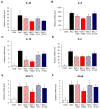Exosomes from Limosilactobacillus fermentum Ameliorate Benzalkonium Chloride-Induced Inflammation in Conjunctival Cells
- PMID: 39596346
- PMCID: PMC11595052
- DOI: 10.3390/ijms252212282
Exosomes from Limosilactobacillus fermentum Ameliorate Benzalkonium Chloride-Induced Inflammation in Conjunctival Cells
Abstract
Dry eye is characterized by persistent instability and decreased tear production, which are accompanied by epithelial lesions and inflammation on the surface of the eye. In our previous paper, we reported that supplementation with Limosilactobacillus fermentum HY7302 (HY7302) could inhibit corneal damage in a benzalkonium chloride (BAC)-induced mouse model of dry eye, through its effects in gut microbiome regulation. The aim of this study was to determine what functional extracellular substances can alter the inflammatory response of conjunctival cells. We isolated exosomes from HY7302 probiotic culture supernatant, analyzed their morphological characteristics, and found that their average size was 143.8 ± 1.1 nm, which was smaller than the exosomes from the L. fermentum KCTC 3112 strain. In addition, HY7302-derived exosomes significantly reduced the levels of genes encoding pro-inflammatory cytokines, including interleukin (IL)-20, IL-8, IL-6, and IL-1B, in BAC-treated human conjunctival cells. Moreover, HY7302-derived exosomes significantly increased the levels of genes encoding tight junction proteins, including TJP1, TJP2, and occludin-1, in Caco-2 cells. Lastly, the HY7302 exosomes reduced mRNA expression levels of IL1B, IL20, IL6, IL8, and NFAT5 in a transwell coculture system. Our findings indicate that HY7302 exosomes have potential for use in the treatment of ocular inflammation-related dry eye disease, through gut-eye axis communication via exosomes.
Keywords: Limosilactobacillus fermentum HY7302; conjunctiva cell; exosomes; ocular inflammation.
Conflict of interest statement
The authors Kippeum Lee, Hyeonjun Gwon, Jae Jung Shim, Joo Yun Kim and Jae Hwan Lee were employed by the company Hy Co., Ltd. The authors declare that the research was conducted in the absence of any commercial or financial relationships that could be construed as potential conflicts of interest.
Figures






References
-
- Phadatare S.P., Momin M., Nighojkar P., Askarkar S., Singh K.K. A comprehensive review on dry eye disease: Diagnosis, medical management, recent developments, and future challenges. Adv. Pharm. 2015;2015:704946. doi: 10.1155/2015/704946. - DOI
-
- Boboridis K.G., Messmer E.M., Benítez-del-Castillo J., Meunier J., Sloesen B., O’Brien P., Quadrado M.J., Rolando M., Labetoulle M. Patient-reported burden and overall impact of dry eye disease across eight European countries: A cross-sectional web-based survey. BMJ Open. 2023;13:e067007. doi: 10.1136/bmjopen-2022-067007. - DOI - PMC - PubMed
MeSH terms
Substances
LinkOut - more resources
Full Text Sources
Molecular Biology Databases

